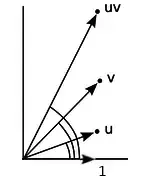Every complex number can be written in the form $r e^{i \theta}$. This follows from Euler's identity
$$
e^{i \theta} = \cos(\theta) + i \sin(\theta).
$$
For a given complex number $z$, you can see how to pick $\theta$ and $r$ so that
$z = r e^{i \theta}$. (By the way, you can prove Euler's identity by plugging $i \theta$ into the Taylor series for $e^x$ -- it's one of the most fun calculations in math.)
So, if $z_1 = r_1 e^{i \theta_1}$ and $z_2 = r_2 e^{i \theta_2}$, then
$$
z_1 z_2 = r_1 r_2 e^{i(\theta_1 + \theta_2)}.
$$
In other words, to multiply two complex numbers, we "add the angles and multiply the lengths".
Edit:
Here is an alternative answer that avoids using Euler's identity. Even without Euler's identity, it's clear that any complex number $z$ can be written in the form
$$
z = r(\cos \theta + i \sin \theta).
$$
So, suppose that $z_1 = r_1 (\cos \theta_1 + i \sin \theta_1)$
and $z_2 = r_2 (\cos \theta_2 + i \sin \theta_2)$.
Now multiply $z_1$ and $z_2$:
$$
z_1 z_2 = r_1 r_2 (\cos \theta_1 \cos \theta_2 - \sin \theta_1 \sin \theta_2)
+ i r_1 r_2(\cos \theta_1 \sin \theta_2 + \sin \theta_1 \cos \theta_2).
$$
If you remember the addition formulas from trigonometry, we recognize that they have miraculously appeared on the right hand side. So we have discovered that
$$
z_1 z_2 = r_1 r_2( \cos(\theta_1 + \theta_2) + i \sin(\theta_1 + \theta_2)).
$$
This shows, again, that when we multiply complex numbers we add the angles and multiply the lengths.
Comments: One might object that in this alternative proof, the appearance of the sum formulas for sine and cosine seems like a miracle. So I probably prefer the first proof that uses Euler's identity. However, one might object that Euler's identity is itself a miracle, because when we plug $i \theta$ into the Taylor series for $e^x$, we are shocked to find that sine and cosine pop out. (At least, I don't see why I shouldn't be shocked.) When things work out this nicely, we know we have stumbled upon something perfect and beautiful.
